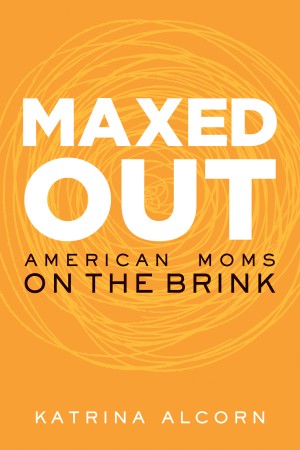 I recently had tea with Christine Carter, a widely-recognized expert in the science of happiness, and the author of my favorite parenting book, Raising Happiness, to ask her this:
I recently had tea with Christine Carter, a widely-recognized expert in the science of happiness, and the author of my favorite parenting book, Raising Happiness, to ask her this:
While we’re waiting around for workplace and economic reform, what can do we for ourselves, to keep from burning out?
Carter immediately launched into the concept of “flourishing.” Before I get to her advice, you first have to understand a little about the research on flourishing. Flourishing is basically a scientific term for people who are regularly happy, but it’s actually more than that.
When you flourish, you don’t just feel different, you are different.
“Seventeen percent of adults are ‘flourishing,’ meaning, they live in a different state of consciousness than the rest of us,” Carter says. “For every negative emotion they experience, they experience at least three positive emotions. Most of us experience the opposite—one positive emotion for every three negative ones.”
If we can reverse that ratio and enter a state of “flourishing,” studies show our actual physiology changes. We become more fluid verbally, and more creative; we become better at solving problems; we have more energy . . . the list goes on.
“It’s not just that you’re doing different things when you enter this state,” Carter says. “You have a different engine.” In other words, when you’re flourishing, your brain is actually working better. You have more resources. Which, of course, makes you feel good. It’s a positive spiral.
How does one “flourish”?
The short answer: We have to get our ratio of positive to negative emotions at 3:1.
This may sound like a bit of a chicken-and-egg thing. To feel better, we must enter a state of flourishing. To flourish, we must . . . feel more positive emotions. But stay with me; it’s all based on sound science.
As Carter explained it to me, when you experience a positive emotion, your vagus nerve is activated, which stimulates your parasympathetic nervous system. When you experience many positive emotions over time, you train your nervous system to be more resilient. This is our goal.
Well then . . . how do you get your ratio of positive to negative emotions up?
Carter recommends that we make a go-to list of things that we know will create positive emotions for us. The list should be specific to what we know makes us feel good. For example, you might have “Take a bubble bath” on your list, while mine may say, “Go for a bike ride.” What matters is that you know these things have a positive effect on your emotions. (Ideally, most of them take less than five minutes, which would make busy, overworked parents more likely to do them.)
OK, did you get all that? Our goal is to make our nervous systems more resilient by inducing more positive emotions throughout each day. With that in mind, here are 10 suggestions for your personal Happy List.
1. Summon Gratitude.
You can put something specific on your list that you are grateful for, or you can choose something different each time. “If you think of something novel,” Carter says, “it will evoke a bigger nervous system response.”
Suggestions: Your kids, your partner, your health
2. Celebrate.
Find a small reason to celebrate. Even little gestures like opening a bottle of wine to celebrate your spouse finishing a project at work can give you a burst of positive emotion.
Suggestions: Write a birthday card for a friend; get ice cream for a child who finished her math workbook.
3. Laugh.
A longer way of saying this is evoke positive emotions about the present. Carter suggests bookmarking a funny animal video, or something that you know is guaranteed to give you a moment of mirth.
Suggestions: Carter’s favorite source of laughter is Nancy Davis Kho’s humor blog about middle age: Midlife Mixtape. Find more ways to laugh here.
4. Evoke Compassion.
Take a moment to feel compassion for another person. This is an act of kindness for the other person, and also for your own nervous system.
Suggestions: Give someone a hug; make eye contact with a homeless person; pay the toll for the person behind you.
5. Have a Moment of Self-Compassion.
Carter warns that people should not use this list to distract themselves from negative emotions that need to be processed. If anything, she says, we need to bring awareness to these negative emotions. Often emotions like grief are sending us a message we need to hear. But if we’re ruminating—getting stuck in a thought pattern that is not productive—then the Happy List can be a valuable tool.
Suggestions: Acknowledge a recent loss you’ve been trying to ignore, or tell a close friend about it. For those of you who, like me, have trouble crying, I suggest chopping onions or listening to The Moth.
6. Find Inspiration.
This is where those book-marked videos come into play again. Carter says this video of Libby Sauter crossing Yosemite on a high wire always makes her cry—in a good way. “For some reason, it gets me every single time.” For other people, an experience of nature or God may be the thing to give them a moment of awe. In that moment, your brain activity changes for the better.
Suggestions: Walk in nature; pray; read “Wild Geese” or your favorite poem out loud.
7. Listen to Music.
Carter recommends making a playlist of songs that are bound to get you in a good mood. She has Martin Sexton’s “Happy” on her list. “I don’t care if it’s a cliché,” she says with a laugh. “It works for me!”
Suggestions: On my happy playlist (also cliché, but they work for me): “Blurred Lines,” “Get Lucky,” and “You Are the Sunshine of My Life.”
8. Exercise.
If you’re stressed, exercise will clear out those stress hormones. Carter says make sure the form of exercise you choose is something you find fun.
Suggestions: Go for a short run; dance in your kitchen; walk the dog.
9. Breathe.
Well, you’re always breathing, but pick a breathing technique that you know helps you relax. Here’s the one Carter likes: Inhale for five seconds, hold the breath for a second, until you feel your heart beat, then exhale for ten seconds. She does this for two minutes, and feels immediate results.
Suggestions: Here is the breathing technique that always works for me: Breathe in slowly through your nose for four counts, then out through your mouth for eight counts. As you breathe out, make an audible sigh. I demonstrated this for Carter as we sat in Starbucks, sipping tea, and she confirmed that the sound you make probably stimulates the vegus nerve, which is why it’s so effective. I feel immediate benefits after two to three breaths.
10. Connect with a Friend.
Connecting with a friend will create a positive emotion, with one caveat. Carter warns that unless you need to process a negative event that happened recently (see #5 on this list), try keeping the conversation positive, rather than talking about what’s stressing you out.
Suggestions: Pick up the phone and call a loved one.
A version of this post appeared on Katrina’s awesome site, www.workingmomsbreak.com. Katrina Alcorn is the author of Maxed Out: American Moms on the Brink was published in September 2013 with Seal Press/The Perseus Books Group. She blogs regularly about topics important to working moms and families on her site, Working Moms Break, in addition to running her own UX business.



